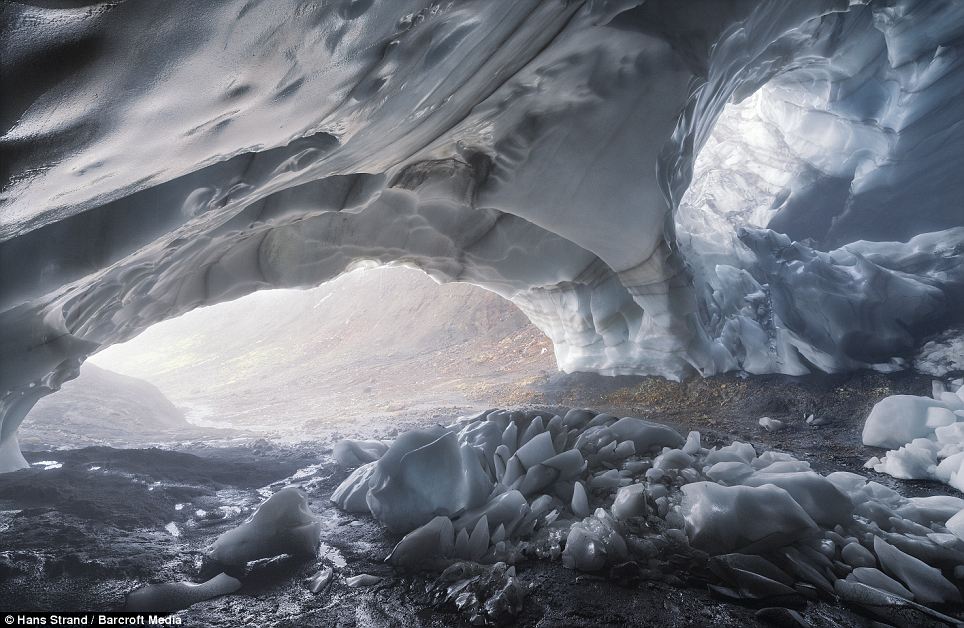A glacier is a huge mass of ice that moves slowly over land. The term “glacier” comes from the French word glace (glah-SAY), which means ice. Glaciers are often called “rivers of ice.” Glaciers fall into two groups: alpine glaciers and ice sheets...
Alpine glaciers form on mountainsides and move downward through valleys. Sometimes, alpine glaciers create or deepen valleys by pushing dirt, soil, and other materials out of their way. Alpine glaciers are found in high mountains of every continent except Australia (although there are many in New Zealand). The Gorner Glacier in Switzerland and the Furtwangler Glacier in Tanzania are both typical alpine glaciers. Alpine glaciers are also called valley glaciers or mountain glaciers.
Ice sheets, unlike alpine glaciers, are not limited to mountainous areas. They form broad domes and spread out from their centers in all directions. As ice sheets spread, they cover everything around them with a thick blanket of ice, including valleys, plains, and even entire mountains. The largest ice sheets, called continental glaciers, spread over vast areas. Today, continental glaciers cover most of Antarctica and the island of Greenland.
Massive ice sheets covered much of North America and Europe during the Pleistocene time period. This was the last glacial period, also known as the Ice Age. Ice sheets reached their greatest size about 18,000 years ago. As the ancient glaciers spread, they carved and changed the Earth’s surface, creating many of the landscapes that exist today. During the Pleistocene Ice Age, nearly one-third of the Earth’s land was covered by glaciers. Today, about one-tenth of the Earth’s land is covered by glacial ice. [Wiki]
How Glaciers Form:
Glaciers begin forming in places where more snow piles up each year than melts. Soon after falling, the snow begins to compress, or become denser and tightly packed. It slowly changes from light, fluffy crystals to hard, round ice pellets. New snow falls and buries this granular snow. The hard snow becomes even more compressed. It becomes a dense, grainy ice called firn. The process of snow compacting into glacial firn is called firnification.
As years go by, layers of firn build on top of each other. When the ice grows thick enough—about 50 meters (160 feet)—the firn grains fuse into a huge mass of solid ice. The glacier begins to move under its own weight. It does this through a process called compression melting. The glacier is so heavy and exerts so much pressure that the firn and snow melt without any increase in temperature. (Most substances do not melt under pressure. Water is somewhat unusual.) The meltwater makes the bottom of the heavy glacier slicker and more able to spread across the landscape.
Pulled by gravity, an alpine glacier moves slowly down a valley. Some glaciers, called hanging glaciers, don't flow the entire length of a mountain. Avalanches and icefalls transfer glacial ice from hanging glaciers to a larger glacier beneath them, or directly to the valley below.
An ice sheet spreads out from its center. The great mass of ice in a glacier behaves plastically, or like a liquid. It flows, oozes, and slides over uneven surfaces until it covers everything in its path. [Complete]
Ice sheets, unlike alpine glaciers, are not limited to mountainous areas. They form broad domes and spread out from their centers in all directions. As ice sheets spread, they cover everything around them with a thick blanket of ice, including valleys, plains, and even entire mountains. The largest ice sheets, called continental glaciers, spread over vast areas. Today, continental glaciers cover most of Antarctica and the island of Greenland.
Massive ice sheets covered much of North America and Europe during the Pleistocene time period. This was the last glacial period, also known as the Ice Age. Ice sheets reached their greatest size about 18,000 years ago. As the ancient glaciers spread, they carved and changed the Earth’s surface, creating many of the landscapes that exist today. During the Pleistocene Ice Age, nearly one-third of the Earth’s land was covered by glaciers. Today, about one-tenth of the Earth’s land is covered by glacial ice. [Wiki]
How Glaciers Form:
Glaciers begin forming in places where more snow piles up each year than melts. Soon after falling, the snow begins to compress, or become denser and tightly packed. It slowly changes from light, fluffy crystals to hard, round ice pellets. New snow falls and buries this granular snow. The hard snow becomes even more compressed. It becomes a dense, grainy ice called firn. The process of snow compacting into glacial firn is called firnification.
As years go by, layers of firn build on top of each other. When the ice grows thick enough—about 50 meters (160 feet)—the firn grains fuse into a huge mass of solid ice. The glacier begins to move under its own weight. It does this through a process called compression melting. The glacier is so heavy and exerts so much pressure that the firn and snow melt without any increase in temperature. (Most substances do not melt under pressure. Water is somewhat unusual.) The meltwater makes the bottom of the heavy glacier slicker and more able to spread across the landscape.
Pulled by gravity, an alpine glacier moves slowly down a valley. Some glaciers, called hanging glaciers, don't flow the entire length of a mountain. Avalanches and icefalls transfer glacial ice from hanging glaciers to a larger glacier beneath them, or directly to the valley below.



















No comments:
Post a Comment